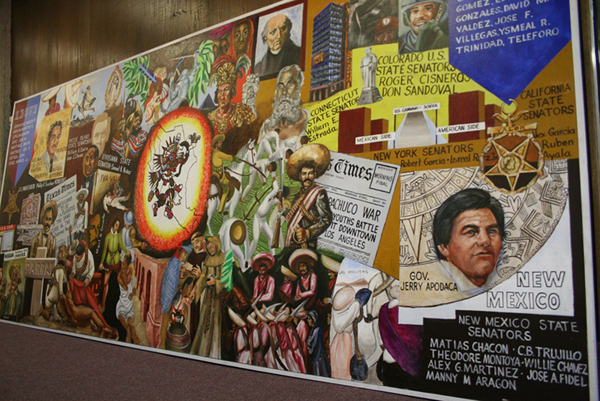Bicentennial mural to be moved to WIB
Moving the bicentennial mural reflecting the history of Chicanos in the Southwest, from the library was a collective decision between Vice Chancellor, Greg Benson; occupants in the Western Instructional Building, and librarians.

This archived article was written by: Valeria Moncada
Moving the bicentennial mural reflecting the history of Chicanos in the Southwest, from the library was a collective decision between Vice Chancellor, Greg Benson; occupants in the Western Instructional Building, and librarians.
The mural is being moved from the library to WIB, because it wasn’t displayed in an area that would accommodate it. The reason the WIB was chosen was because the mural ties in with humanities and those classes are located in the WIB, also the walls in the WIB are much more accommodating for the 20 foot by 8 foot mural. But the main reason the WIB was chosen was because a lot of people travel through the WIB everyday.
“At the time the mural was put up in the library, it was probably a good space for it, but at the years passed it became obscured,” said Vice Chancellor Benson.
The mural represents the on-going struggle of the Chicano in the Southwest and was painted by an artist from Salt Lake City named Aldredo de Aila. It marked the completion of a four year Utah State Bicentennial Commission project. The assemblage mural cost $3,000, according to a 1978 article of the Sun Advocate.
A film was also included in this project, showing the history and some of the areas of Carbon County and the construction of the East Carbon City Community Center.
The assemblage mural was officially unveiled on May 5, 1978; on the Hispanic holiday Cinco De Mayo, reported the Sun Advocate article.
The Southwest Chicano Heritage Committee, which involved Anita Mestas, the director of the Chicano studies at CEU, James Young, CEU professor of art; Clorinda Cordova, a Chicano community representative; Elliot Fairbanks, a CEU representative; Jennie Vilegos, a Chicano community representative and Carbon County Chapter of SOCIO president; and Dr. Alfonso Trujillo, the first assistant chair of the commission.
At the time, Mestas called the mural “culturally important” to Carbon County, she said it would enhance the communities understanding of the Chicano, reported the Sun Advocate.
“The struggle of the Chicano is that of seeking his identity through the past, in today’s society and hope in his aspirations for tomorrow,” Mestas had said. She also included that “the portrayals of Aztec leaders Montezuma, Cuauhtemoc and Hernan Cortez, a Spanish conquistador, all whom developed a new breed called Mestizos in the article.”
The mural includes heroes of the Mexican Revolution, Father Miguel Hidalgo with his “Grito de Dolores” of 1821; Don Benito Juarez, guardian of the constitution; the Adelitas women who fought side by side with their men; the Revolutionaries, Pancho Villa and Emiliano Zapata; the despot Diaz and the “Apostle of the Constitution,” Fransisco Madero.
The mural also shows the importance of the Catholic religion with La Virgen de Guadalupe, also known as the Virgin Mary; and the humble Juan Diego. Another scene in the mural shows the significance of the coal industry in Carbon County and the Chicanos who work in it, reported the Sun Advocate.
Benson hopes to have the mural moved sometime within the next month, where it will be more noticeable to the students, faculty and staff.




